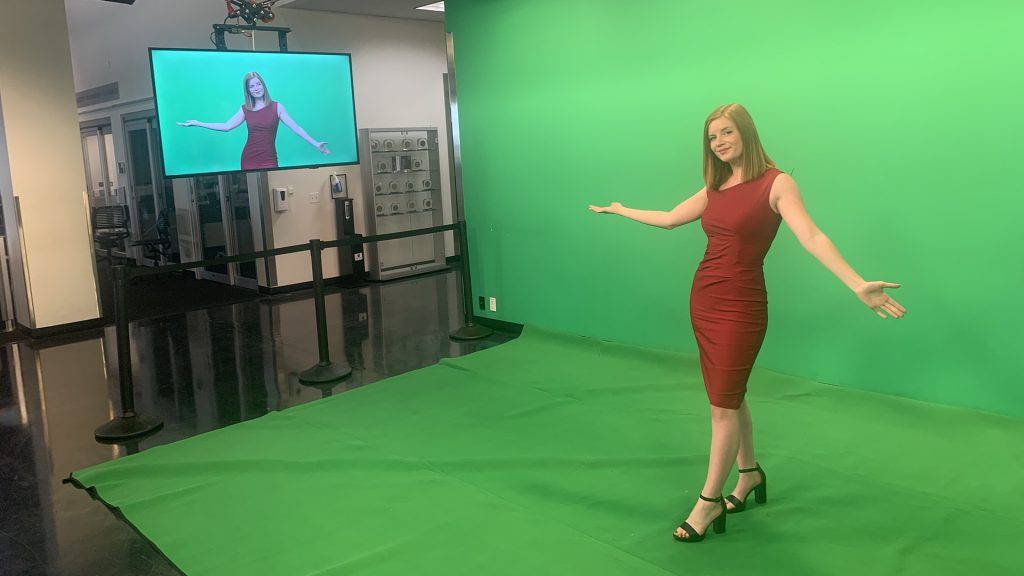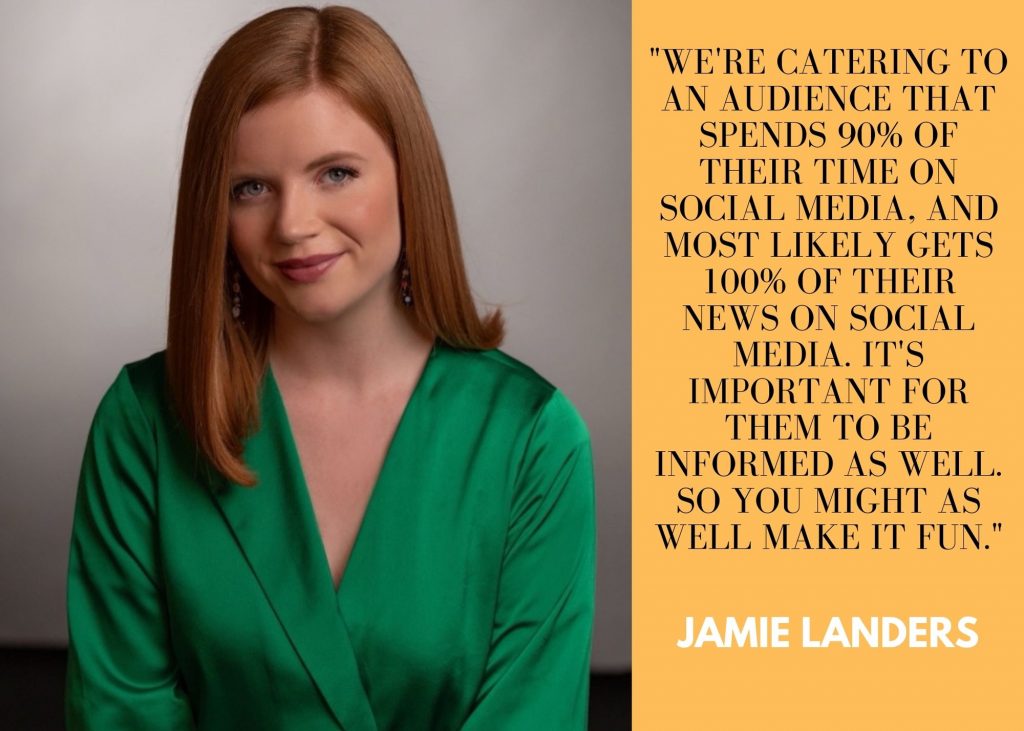
The video is informative and slickly produced: a 1:42 “explainer” in which a reporter deftly interacts with animated on-screen graphics and data to bring a potentially dry story on COVID-19’s global impact to life.
The segment is a social media extension of the Health Insider series on Scripps station KNXV (ABC15) in Phoenix, but the reporter, Jamie Landers, doesn’t work for the station. Landers is a May graduate of the Walter Cronkite School of Journalism and Mass Communication at ASU, and she created the video using a green screen and a tool called Moovly as part of an unusual experiment in collaboration between a local TV newsroom and a journalism school.
WATCH the Jamie Landers explainer on COVID’s global spread
For the station, the project is an opportunity to expand its on-air health franchise to new users on social media platforms, including people who are unlikely to watch a traditional newscast, as well as to find out which techniques and platforms are most successful. The students produce the videos, but the station decides where to post them: Facebook, Instagram, Twitter or a combination.
“I think part of it is giving a fresh perspective to how we’re covering digital news,” says Courtland Jeffrey, a senior digital editor who along with his ABC15 colleague Katie Fisher works closely with the students. (Fisher and Jeffrey are both Cronkite grads: it’s a cozy fit.) “I think we tend to get in the trenches of what we know works, but this kind of took off the reins and just let us go free and say, ‘Hey, let’s try these things. Let’s try these other different tools out. Let’s try these other visual formats out and see how they connect with our audience,’” Jeffrey says.
 Click above to WATCH an explainer on the Delta variant on ABC15’s Facebook page
Click above to WATCH an explainer on the Delta variant on ABC15’s Facebook page
And why Cronkite News? The bespoke work for a commercial station is part of the newsroom’s participation in Table Stakes, a 10-month challenge-based innovation program for local TV newsrooms based at ASU and funded by the Knight Foundation, which also underwrites our work here at the Lab. (ABC15 went through Table Stakes itself in the 2018-19 session.)
One explicit goal in Cronkite News’s Table Stakes challenge is to “harness the cool” of the students, whose media habits and savvy reflect their own peer group — and therefore the news consumers of tomorrow. “Who better to help reach the younger generation than people in the generation,” says Isaac Easley, a Cronkite video journalism and innovation instructor who works closely with the student team. “We’re catering to an audience that spends 90% of their time on social media, and most likely gets 100% of their news on social media,” says Landers. “And it’s important for them to be informed as well. So you might as well make it fun.”
WATCH a Simon Williams explainer on “brain fog”
The core team at Cronkite News is a three-person “innovation squad” — currently consisting of Landers, Jordan Spurgeon, and Simon Williams — that has been creating explainers at a pace of one or two a week since the spring. (The project wraps up next week.) The Cronkite crew meets with Fisher and Jeffrey every week to plan and compare notes.
Most of the videos draw on the station’s reporting, but the students also contribute their own ideas. In addition to Moovly, they have experimented with tools like Wideo and VideoScribe and Vyond and techniques like stop-motion and anime and flipbook animation.
Topics range widely. Some examples: whether youth sports leagues will require vaccinations; the difference between heat stroke and heat exhaustion; COVID vaccine side effects; understanding sunscreen SPF levels; brain fog, and the newly approved Alzheimer’s treatment (a stop-motion explainer using creative arrangements of M&Ms).
WATCH the team use M&Ms and stop-motion to explain a new Alzheimer’s treatment
ABC15 hasn’t put any of the student videos on television — just its social media pages — but Fisher says segments like the Landers story on COVID’s global expansion are already suggesting ways to add a valuable element to the station’s newscasts. “That could easily have an application for on-air,” she says. “It’s the depth, it’s the context, it’s showing the viewer in a visual way, breaking it down in a new way. And they are trying to do that more in our on-air broadcasts.”
WATCH a flipbook explainer on heat-related ailments
Both the students and the ABC15 editors keep meticulous records of what has worked best on which platforms — and what hasn’t. Timeliness and topicality are a constant concern, “Innovation takes time. And not all of it works,” says Easley. “It’s walking that tightrope between trying something new, and trying to meet the deadline. So finding that balance between creativity and making it timely was always a big challenge.”

To that end, the students also post information about each tool, including its ease (or difficulty) of use. Cronkite News plans to publish an online playbook with all its findings by the end of this month, so that every newsroom, including yours, can profit from the lessons learned. “We had a lot of fun doing it and learned a lot from it. So for us it was a success. Now the next step is sharing the results with the rest of the world,” says Christina Leonard, who oversees the project as executive editor of Cronkite News. “Everybody else gets to reap the benefits of our experiment and see if they want to give it a shot.”
WATCH Jordan Spurgeon’s anime explainer on youth sports leagues
How hard would it actually be for other newsrooms to replicate this experiment? Thanks to the Knight funding, ABC15 didn’t have to pay for the school’s work, but the students also benefited greatly from the station’s guidance and from exposure to its larger audience. If collaborating with a journalism school isn’t an option, a newsroom has to decide whether to invest some of its own resources to train reporters and producers to create these explainers.

“I think it’s 100% worth it,” says Landers. “That’s what I would tell a news director. It’s never a waste of time to try to grab one more person’s attention. I think people are hungry for information, but they’re not clicking on digital articles and going behind paywalls anymore. They’re not sitting down at 6 p.m. and watching your evening newscast. And if you know that, it is up to you to do your best to find a different way. So I think it is worth it to train your reporters, and I can guarantee that they can do it.”
But in addition to spending time and money, a key ingredient in this experiment — and a hallmark of most successful innovation efforts — is the willingness to fail, learn from the setbacks, and quickly move on. “Everything that you try for the first time is daunting and frustrating,” Landers says. “But if you push past that, that’s where the good stuff comes from.”
Maybe this time, the students are the ones teaching us.
Get the Lab Report: The most important stories delivered to your inbox